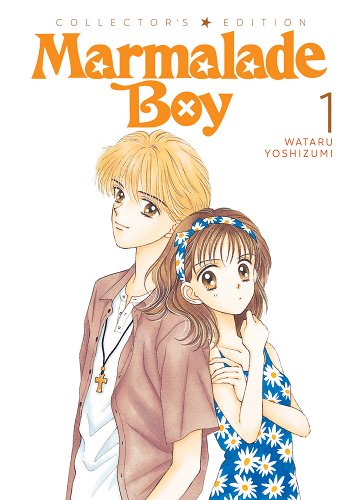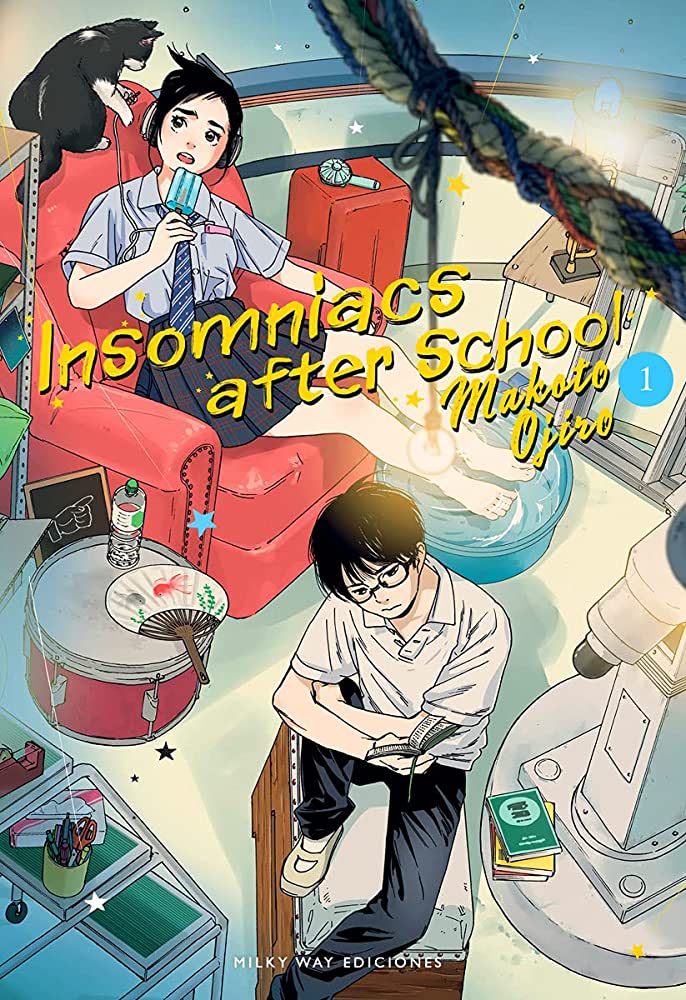One of shojo manga’s most time-honored plot lines goes something like this: a young girl’s life is turned upside down when her mother or father remarries someone with a teenager of their own, usually a cute boy who’s smart, athletic, and insufferable. Over the course of six or ten volumes, however, the heroine gradually moves from indignation to infatuation, finally admitting to herself what everyone else could plainly see: she likes her stepbrother. There are a usually a few complications on the way to a blissful relationship—say, a crazy ex-girlfriend who won’t go away—but the step-siblings eventually realize that they’re meant to be together.
Wataru Yoshizumi’s Marmalade Boy adds a new wrinkle to the formula, however, by engineering a crazy scenario for bringing her romantic antagonists under the same roof. In the opening pages of volume one, fifteen-year-old Miki Koishikawa’s parents come back from a trip with shocking news: they’re getting divorced. Making matters worse is that the Koishikawas have decided to swap partners with the Matsuras, a couple they met while traveling, and combine their families into a single household that includes both Miki and the Matsuras’ son Yuu. Yuu, of course, is a quintessential shojo prince: he’s gifted at tennis, an ace at math, and popular at school and—naturally—Miki hates him. She finds him smug in his refusal to criticize their parents’ impulsive behavior, and is furious that no one seems to understand her reservations about their new living situation.
Their blended family life is established with great efficiency, setting the stage for plenty of misunderstandings and fights between Miki and Yuu. Yoshizumi also wastes no time in introducing other romantic prospects for both leads; a good part of volume one, in fact, follows the complicated friendship between Miki and Ginta, a cute tennis player who Miki used to like. Yuu, meanwhile, has his own romantic travails when his ex-girlfriend Arimi tracks him down at his new school, determined to rekindle their relationship by any means necessary. And if all those potential entanglements weren’t enough to fill thirty or forty chapters, Miki’s best friend Meiko starts hooking up with her hot homeroom teacher in the school library.
If I’m reading the story in Responsible Adult Mode™, it’s hard to ignore all the WTF? shenanigans. In one of the weirdest scenes in volume one, for example, the Matsuras and Koishikawas stage a fight to see whether Miki truly disapproves of their living arrangement, confessing their deceit only after a tearful Miki begs them to follow their hearts. The sight of all four parents gaslighting their daughter is comically awful; I’d be the first to admit that I’m on Team Miki, as she seems to be the only person who grasps the impulsiveness of the adults’ spouse-swapping arrangement. Then there are the usual shojo red flags: student-teacher relationships, stolen kisses, and characters whose behavior sails over the line between friendly interest and stalking.
If I allow myself to reconnect with my inner twelve-year-old, however, I have to admit that Marmalade Boy is funny, silly, and engrossing, offering a teenage gloss on Dynasty or Melrose Place. It’s the kind of manga in which two romantic rivals settle their differences with a high-stakes tennis match—in front of the whole school, of course—and characters state their intentions in a bald fashion: “I won’t lose you to him,” Arimi cheerfully warns Miki over a sundae. (A sundae!) Yoshizumi’s ability to balance the absurd with the everyday lends an air of plausibility to these scenarios; there’s always a kernel of emotional truth to the interactions between the characters, even when they’re dreaming up soap-worthy schemes.
Though the plotting is intricate, the artwork is clean and unfussy; backgrounds, hairdos, and clothing are rendered in a style that keeps the focus on the characters’ faces and body language. Miki has big, dramatic reactions to everything, but Yoshizumi avoids too much deformation or mugging to convey Miki’s distress. More surprising is how gracefully the artwork has aged, aside from an errant headband here and there; it wouldn’t look out of place at Barnes & Noble in 2023. (Well, that’s not entirely true; Yuu has a major case of 90s Shojo Prince Hair™, notable for its height and for the artful way it flops to one side of his face.)
All of this is to say that I enjoyed Marmalade Boy waaaaaaaaaay more than I expected, given my advanced age and my strong preference for stories about, y’know, adults. I cheerfully recommend it to anyone looking to recapture the feeling of reading their first shojo manga, or the palpable excitement of being a manga fan in the early 2000s, when Tokyopop published these kind of stories by the truckfull. Recommended.
MARMALADE BOY: COLLECTOR’S EDITION, VOL. 1 • BY WATARU YOSHIZUMI • TRANSLATED BY AMBER TAMOSAITIS • ADAPTED BY KRISTA GRANDY • LETTERING BY JENNIFER SKARUPA • SEVEN SEAS • RATED TEEN+



